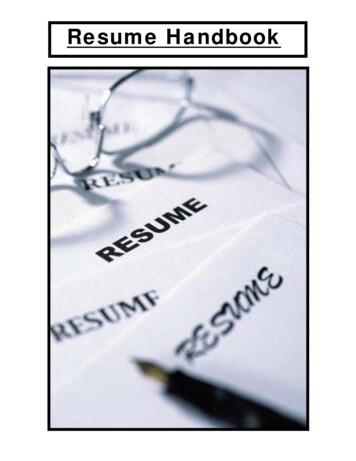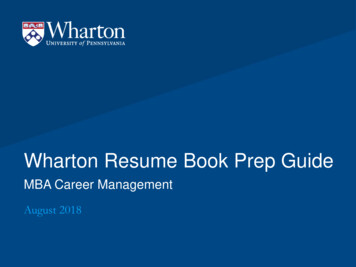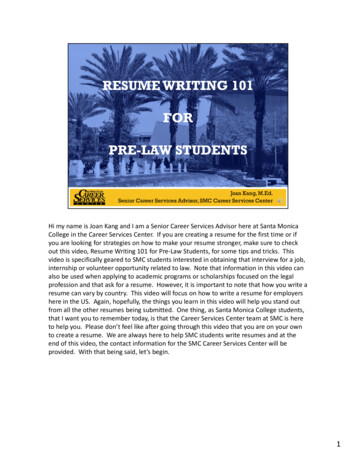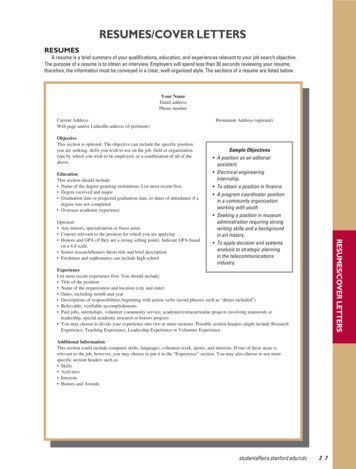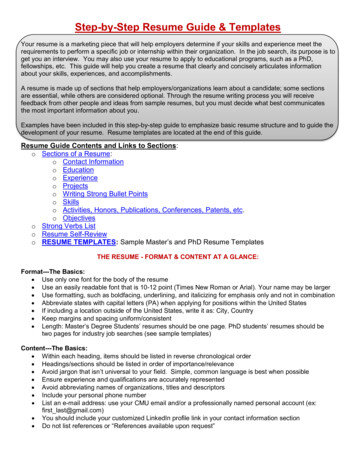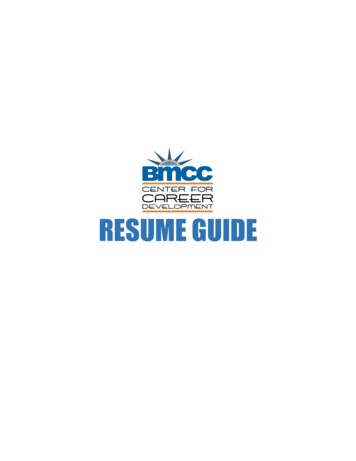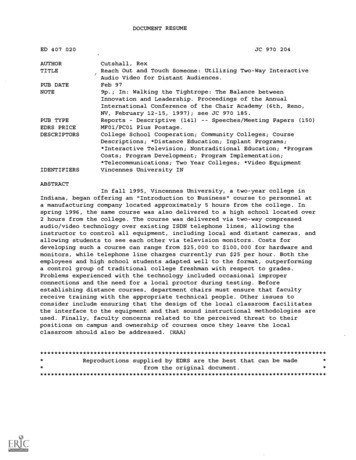
Transcription
DOCUMENT RESUMEED 407 020AUTHORTITLEPUB DATENOTEPUB TYPEEDRS PRICEDESCRIPTORSIDENTIFIERSJC 970 204Cutshall, RexReach Out and Touch Someone: Utilizing Two-Way InteractiveAudio Video for Distant Audiences.Feb 979p.; In: Walking the Tightrope: The Balance betweenInnovation and Leadership. Proceedings of the AnnualInternational Conference of the Chair Academy (6th, Reno,NV, February 12-15, 1997); see JC 970 185.ReportsDescriptive (141)Speeches/Meeting Papers (150)MF01/PC01 Plus Postage.College School Cooperation; Community Colleges; CourseDescriptions; *Distance Education; Inplant Programs;*Interactive Television; Nontraditional Education; *ProgramCosts; Program Development; Program Implementation;*Telecommunications; Two Year Colleges; *Video EquipmentVincennes University INABSTRACTIn fall 1995, Vincennes University, a two-year college inIndiana, began offering an "Introduction to Business" course to personnel ata manufacturing company located approximately 5 hours from the college. Inspring 1996, the same course was also delivered to a high school located over2 hours from the college. The course was delivered via two-way compressedaudio/video technology over existing ISDN telephone lines, allowing theinstructor to control all equipment, including local and distant cameras, andallowing students to see each other via television monitors. Costs fordeveloping such a course can range from 25,000 to 100,000 for hardware andmonitors, while telephone line charges currently run 25 per hour. Both theemployees and high school students adapted well to the format, outperforminga control group of traditional college freshman with respect to grades.Problems experienced with the technology included occasional improperconnections and the need for a local proctor during testing. Beforeestablishing distance courses, department chairs must ensure that facultyreceive training with the appropriate technical people. Other issues toconsider include ensuring that the design of the local classroom facilitatesthe interface to the equipment and that sound instructional methodologies areused. Finally, faculty concerns related to the perceived threat to theirpositions on campus and ownership of courses once they leave the localclassroom should also be addressed. ***********************************Reproductions supplied by EDRS are the best that can be madefrom the original ***************************************
O6''6'.1QREACH OUT AND TOUCH SOMEONE:UTILIZING TWO-WAY INTERACTIVE AUDIO VIDEOFOR DISTANT AUDIENCESByRex CutshallChair, Management & AccountingVincennes UniversityVincennes, IN"PERMISSION TO REPRODUCE THISMATERIAL HAS BEEN GRANTED BYU.S. DEPARTMENT OF EDUCATIONOffice of Educational Research and C)G. FilankThis dOcument has been reproduced asreceived from the person or organizationoriginating tt.Minor changes have been made to improvereproduction Quality.Points of new or opinions stated in this docu-TO THE EDUCATIONAL RESOURCESINFORMATION CENTER (ERIC)."ment do not necessarily represent officialOERI posdion or policyPaper Presented at theSixth Annual International Conference forCommunity & Technical College Chairs, Deans, and Other Organizational LeadersFebruary 12 - 15, 1997Reno, NevadaACA ID E I\ABEST COPY MAILABLE1982
Presenter BiographyRex R. CutshallCurrent Position:Chairman, Department of Management and Accounting (since 1992)Associate Professor of Business (since 1987)Supervise 6 full-time, 4 part-time facultyTeaching assignments-Business Statistics & Introduction to BusinessPart-Time Appointment with Indiana State University, Dept of Systems and DecisionSciencesEducation:Currently completing Ph.D. in Educational AdministrationMBA-University of EvansvilleBS-Business Admin-Indiana State UniversityAS-Business Admin-Vmcennes UniversityProfessional Accomplishments:Certified Purchasing ManagerAccredited Purchasing PractitionerCertified Consumer ArbitratorAuthored Business Statistics: Microcomputer Experiences Using MinitabSenator, Vincennes University Faculty SenateAccreditation Evaluator, Association of Collegiate Business Schools and ProgramsConsulting Interests:Statistical Process Control; Management Information Systems3199
With increasing concerns about enrollment management and breaking down thetraditional walls of higher education, post-secondary institutions are activelypursuing distant education opportunities. The paper briefly describes one suchattempt to expand the walls of Vincennes University.Prior to the start of the Fall semester 1995, the Business Division of VincennesUniversity (a two year comprehensive community college) was approached by amanufacturing company in Elkhart, Indiana (more than five hours away) todeliver college courses to their personnel. Also, prior to the start of the Springsemester 1996, a distant high school inquired into the availability of a businessclass for dual (high schooVcollege) credit. With the significant distance betweenthe two sites, alternative methods of delivery had to be considered.Utilizing a compressed video technology using ISDN telephone lines, thecourse was delivered directly to the conference room of the manufacturingfacility and to the media center at the distant high school.The course offered was BMM 100 Introduction to Business. This is a surveycourse in business required of virtually all incoming business students atVincennes University.In Spring semester 1996, the same course was delivered to Decatur CentralHigh School in Indianapolis, IN (More than two hours away) for dual credit toselected seniors. The same technology was employed. This course, however,was held concurrently with a local classroom of 24 traditional college studentspresent and the distant high school students.The StudentsThe first audience was a small group of adult learners at a medium sizedmanufacturing facility. The students ranged in age from the early twenties tolate fifties. They represented a broad spectrum of job positions from functionalarea middle-managers to the clerical ranks. Most of these students wereinterested in obtaining an Associate's degree to enhance their promotability atthat specific firm. The class was conducted in the conference room (via the twoway interactive link) of the facility convening immediately following work once aweek. An on-site visit/session was conducted by the instructor to completeneeded classroom hours.2004
The second class (which was executed the very next semester) consisted ofeight high school seniors who enrolled in the class for dual credit. Theseseniors were chosen based on their academic backgrounds (GPA of 3.25 orbetter), their interest in pursuing a business major upon graduation from highschool, and the recommendation of their assistant principal. Most of thestudents had previously completed a General Business class in their freshmanyear. The students attended this class in a multi-media room adjacent to theirlibrary. This room was specifically outfitted for this type of instruction from agrant the school had previously received. A lab assistant was present to initiatethe connection at the beginning of class, but left once class began. Classroomdiscipline was left totally to the distant instructor. The students were assessedtuition at a discounted rate and a local business (donor) subsidized the costs sostudents did not incur any out-of-pocket expense.The Technology used in the delivery of the instructionAfter investigation into the availability of different instructional pedagogies tothese distant audiences (satellite, correspondence, on-sight), the technologychosen was that of two-way compressed audio/video. This technologyconsisted of Picture Tel brand of video conferencing hardware and existing ISDN(Integrated Services Digital Network) telephone lines running at 112K BPSusing high speed modems.In essence, the instructor had the ability to both see and hear the distant classand they could see and hear the instructor. This particular brand of equipmentallows the instructor to control all equipment including cameras (both locally andat the distant location), VCR's, and computer graphics from a single keypadlocated at the instructor's podium.The instructor receives the students' video on a 46 inch big screen televisionand the students had similar monitors (although only 27 inch) at their receivesites. Additionally, the local (larger) classroom had a 27 inch monitor mountedfrom the ceiling to allow the local class to view the distant class. Each receivesite had a designated technician available if troubles were encountered.The hardware cost to outfit a distant education classroom depends on thedesign and purpose desired. At the distant manufacturing location, a portableunit was loaned to them which only includes a 27 inch monitor, camera, and PC.For a more permanent installation, a dedicated .big screen. television/monitor,ceiling microphones, additional monitors, document cameras, and PC's areappropriate.5201
The cost can range from 25,000 (for portables) to 100,000 forlarge/permanent installations. The line charges that are currently encounteredare approximately 25/hour of connection time. These costs are strictlyapproximations and should be fully researched by anyone attempting this typeof technology. Technicians were provided by our telecommunicationsdepartment at an hourly rate 25/hour at the local end. No technical costs wereincurred at the distant end.To initiate a class, the local instructor simply dials a pre-set video telephonenumber and waits for the class to appear on the monitor. Once this occurs, aninteractive class can begin.The Students Reaction/PerformanceAs with any new technology, some apathy and concern was to be expected.This was the first attempt by the Business Division and the University as awhole to broadcast a class outside of its campuses.It must be mentioned here that in the delivery of these two courses the audiencecomposition was quite different. In the first case (to the manufacturing plant),the audience was composed of adult learners entirely. The second coursedelivery was to a traditionally-aged high school senior population.Interestingly, both of these audiences adapted quite well and quickly to thistechnology. The acclimation to the use of the equipment was usuallyaccomplished during the first class session. Most probably, this is due to thetechnological interface most all of us experience today in our daily life andactivities.The performance of both of these audiences was compared to a control group oftraditional college freshman in a traditional lecture/discussion format. Theresults of the performance of the student in the course, based on final coursegrades, indicated in both deliveries performance that was greater than thetraditional college population.A statistical analysis of the data was performed to validate this observation.Descriptive statistics revealed higher average final course grades of distantstudents and a one-way ANOVA showed at statistically significant differencebetween these means of the populations.6202
Mean Final GradesTraditional ClassroomIndustrial GroupHighSchool GroupF statistic (ANOVA)P Value73%80%93%5.85(ANOVA).007This success is most likely due to the added motivation of the students tosucceed as indicated by their commitment to take a class via non-traditionalinstructional techniques.Pitfalls of this TechnologyAs with any situation that relies heavily on the use of technology, theconvenience of this instructional methodology does not come without itspotential problems. Occasionally, the technology might not connect properly(many times due to factors outside the control of the originator) and acontingency plan must be available to insure the continuity of instruction. Somesuggested alternatives might include study guides/sessions, library researchassignments relating to the material being studied, etc. The failure of a classconnection should not necessarily be equated with class cancellation.For testing purposes, the use of a local proctor is needed. Additionally, fortimely grading and returning of exams/quizzes, the fax machine needed to beused often.Without a motivated, dedicated class, an instructor would not have a greatdegree of classroom discipline. Again, a proctor might alleviate this potentialconcern.Most importantly, the use of this technology will force an instructor to reconsiderthe techniques used in the traditional classroom to be more conducive tovideo/television reception (the old .talking head. will not suffice on the television)The appropriateness of this technology for specific courses/ audiencesI personally believe that this technology can be employed for virtually all types ofinstruction. The hardware supports not only cameras, but also documentcameras for the displaying of print material, VCR's for video tapes, computerinterfaces for graphics/presentation packages such as Powepoint or thedemonstration of the Internet.7203
The courses that have been delivered via this technology at VincennesUniversity include:- General PsychologyIntroduction to BusinessSociology of Relationships and FamiliesPrinciples of ManagementThe psychology and sociology courses were developed to meet the generaleducation requirement within our curriculum for students attending at one of oursatellite campuses.Vincennes University maintains an Aviation Technology Center at Indianapolis,IN (2 hours away) for students majoring in Aviation Maintenance and AviationFlight majors.The more technical, skill-based courses are taught by full time faculty and thegeneral education courses are left to adjunct and main campus faculty.The Principles of Management class was offered to the same industry-basedaudience (in Elkhart, IN) as the original Introduction to Business class.Courses that are currently being developed include a Marketing class and aMathematics class.Administrative Concerns/CostsAs a department chairman as well as the instructor, I can offer several concernsthat need to be addressed both before and during the delivery of a distanteducation course using this technology.First, the development of the course and the faculty member's training must beaddressed. Even though a faculty member may have taught the course severaltimes, it does require some adaptation to be viable to the distant audience.Many models exist as to the amount of time and perhaps compensationawarded to a faculty member, but I have developed the followingrecommendation.For faculty members embarking on this delivery method, a pre-launch trainingsession with the appropriate technical person (on our campus it is thetelecommunications manager).8204
Issues that need to be considered would include:Room Design-The physical arrangement of the classroom must facilitate theinterface to the equipment.Instructional Methodologies-The use of strictly lecture is not conducive todistant audiences. It is very difficult to keep the attention of a distantaudience when they only see a .talking head.Technological Issues-A contingency plan needs to be available if a technicaldifficulty arises.Timing Issues-Homework and quizzes cannot be picked up and distributedfreely during class to a distant audience.Then, for the faculty member to appropriately develop the course, a amount ofrelease time be given just prior or during the delivery of the class. Thisaccommodates any changes needed during the delivery of the class.Additionally, administrative costs associated with the technology needs to beconsidered. These might include connection charges, technician charges,proctor charges (if any), or room rental (if appropriate).Faculty ConcernsThe reaction of faculty to this medium is mixed. Some faculty take the positionthat this could ultimately endanger their position at the local campus. Others areconvinced that the way they present their lectures/materials is so unique that itcould not be done in a broadcast medium. A final concern addresses theownership of the course once it leaves the boundaries of the local classroom.All of these concerns merit some attention. It is the responsibility of theadministration to reassure faculty that this is simply a .paradigm shift. from whatacademia is used to. Most believe that distant education strategies willultimately strengthen and increase enrollments in the long run.The FutureThe Business Division at Vincennes University is committed to deliveringadditional courses through this as well as other mediums. Additionally, asecond course is currently being delivered to the manufacturing facility to buildupon the first business survey course through two-way interactive audio-video.An entire Associate's degree in business is currently being developed with ananticipated launch in the very near future.9205
ERICU.S. Department of EducationOffice of Educational Research and Improvement (OEROEducational Resources Information Center (ERIC)014-0 2-0 REPRODUCTION RELEASE(Specific Document)I. DOCUMENT IDENTIFICATION:Title:Walking the Tightrope: The Balance Between Innovation and Leadership.Proceedings of the Annual International Conference of the ChairAcademx.i6thz Reno, NV4 February 12-15x 1997Author(s):The Chair Academy, et al,Corporate Source:Publication Date:The Chair Academy/Mesa Community CollegeFebruary 1997IL REPRODUCTION RELEASE:In order to disseminate as widely as possible timely and significant materials of interest to the educational community, documents announcedin the monthly abstract journal of the ERIC system, Resources in Education (RIE), are usually made available to users in microfiche, reproducedpaper copy, and electronic/optical media, and sold through the ERIC Document Reproduction Service (EDRS) or other ERIC vendors. Credit isgiven to the source of each document, and, if reproduction release is granted, one of the following notices is affixed to the document.If permission is granted to reproduce and disseminate the identified document, please CHECK ONE of the following two options and sign atthe bottom of the page.IThe sample sticker shown below will beaffixed to all Level 1 documentsThe sample sticker shown below will beaffixed to all Level 2 documentsPERMISSION TO REPRODUCE ANDDISSEMINATE THIS MATERIALHAS BEEN GRANTED BYPERMISSION TO REPRODUCE ANDDISSEMINATE THISMATERIAL IN OTHER THAN PAPERCOPY HAS BEEN GRANTED BYI\eCheck hereFor Level 1 Release:Permitting reproduction inmicrofiche (4" x 6" film) orother ERIC archival media(e.g., electronic or optical)and paper copy.ECheck hereFor Level 2 Release:carTO THE EDUCATIONAL RESOURCESINFORMATION CENTER (ERIC)Level 1Permitting reproduction inmicrofiche (4" x 6' film) orother ERIC archival media(e.g., electronic or optical),but not in paper copy.TO THE EDUCATIONAL RESOURCESINFORMATION CENTER (ERIC)Level 2Documents will be processed as indicated provided reproduction quality permits. If permissionto reproduce is granted, but neither box is checked, documents will be processed at Level 1.hereby grant to the Educational Resources Information Center (ERIC) nonexclusive permission to reproduce and disseminatethis document as indicated above. Reproduction from the ERIC microfiche or electronic/optical media by persons other thanERIC employees and its system contractors requires permission from the copyright holder. Exception is made for non-profitreproduction by libraries and other service : encies to satisfy information needs of educators in response to discrete inquiries.'SignPrinted Name/Position/Title:here-,pleaseR.air AcAciemymcc 1)own bwri Gark,14-1 5 M Cc rykruNia l Way/Ae5G AL 8'saolFi IaneloNTefeliFiOne:(i)190E-mail Address:ualoEx ect. We DirccAorLoa) Litt - U.415Date:4I30( 1lover)
4III. DOCUMENT AVAILABILITY INFORMATION (FROM NON-ERIC SOURCE):If permission to reproduce is not granted to ERIC, or, if you wish ERIC to cite the availability of the document from an
IDENTIFIERS Vincennes University IN. ABSTRACT. In fall 1995, Vincennes University, a two-year college in Indiana, began offering an "Introduction to Business" course to personnel at a manufacturing company located approximately 5 hours from the college. In spring 1996, the sam



